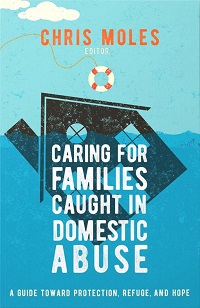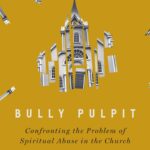Chris Moles, a pastor and abuse counselor has a new book coming out today from New Growth Press to encourage church leaders and counselors to properly address and confront domestic abuse in their churches. His book, Caring for Families Caught in Domestic Abuse: A Guide toward Protection, Refuge, and Hope, features wisdom from a team of counselors and abuse experts who work with both victims and perpetrators of abuse. Contributors to the book include Beth Broom, Kirsten Christianson, Joy Forrest, Chris Moles, Darby Strickland, and Greg Wilson.
In this book, Moles calls us to great patience and humility in dealing with abuse. He calls us to benefit from the years of wisdom and experience of his contributors so we don’t have to make unnecessary mistakes when dealing with real lives. The book covers important topics such as how to recognize abuse, how to recognize trauma and prioritize the safety of victims, how the church can respond using a team approach and church discipline, and how to assess for repentance in perpetrators. There are specific chapters on how to counsel victims, oppressors, and even children.
While dealing with abuse is a daunting task, the church has a great privilege and responsibility to call perpetrators of oppression to repentance and to work with the oppressed within their own congregations. This book shows us that domestic abuse is a matter of gospel witness and integrity, demonstrating how Christ loves his bride and showing that God cares about doing justice and loving mercy. To paraphrase Dr. Diane Langberg, if we open our eyes to see those that are suffering, we may begin to realize that trauma is perhaps the greatest mission field of the 21st century.
What’s the Big Deal About Domestic Abuse?
Why should we even care? Abuse leaves a wake of destruction, emotionally, spiritually, and psychologically. In Greg Wilson’s chapter, “Understanding the Mind and Heart of an Abusive Person” he defines abuse as, “[t]he desecration of the image of God through patterns of intentionally misusing power – covertly or overtly, in words or actions – to gratify self.”
This is a double desecration. There is harm caused to both the perpetrator and the victim, both image bearers of God. “Abuse happens when one image-bearer degrades another image-bearer through cruel or unjust treatment – the exact opposite of how God treats people.” (p.116.)
How is an abusive relationship different than a normal marriage conflict? Wilson explains, that while relational sin may often be competitive, even wanting to win in an argument, abuse is distinguishable by either its parasitic or predatory nature (p.122).
The trauma and harm from abuse is deeper and more pervasive than normal marital conflict. Abuse involves elements of power and control over a person. This power could include financial power, speed, cunning, physical strength, or even misuse of spiritual authority. Abusers use their power to get what they want, in a way that damages a victim and keep victims silent and submissive. In discerning abuse, we look at patterns of destructive, harmful, degrading, or harsh behavior and see its impact on victims.
“Sin that is abusive is “me over you.” It is predatory or parasitic… The harm caused by a predator is more direct, overt, and explicit; the harm caused by a parasite is more indirect, covert, and subtle in its diminishing effect. However, both are abusive, and both are about me using my influence to diminish the personal capacity, the agency, the will of another in the relationship, and controlling them to get what I want.” (A quote from Greg Wilson, p.122-123.)
A Heart For Perpetrators of Abuse
What I appreciated most about Caring for Families Caught in Domestic Abuse was seeing how loving abuse victims and loving perpetrators of abuse were not conflicting goals that were at odds with each other. In particular, it was encouraging to hear Wilson’s and Moles’s heart for perpetrators of abuse.
“If we are to care well for families caught up in the chaos of domestic abuse, we must be able to see the abusive person fully and rightly and help him see himself fully and rightly. If he does, there is a better chance that he will turn from his abusive behaviors and lead a life marked by humility, grace, and peace. And it is far more likely that those in close relationship with him will experience flourishing rather than destruction.” (A quote from Greg Wilson, p.130).
Likewise, Moles calls us to love and confront abusers with gentleness. He warns that the temptation when dealing with abusers is to become like them: angry, manipulative, controlling and demeaning. He instead calls us to be controlled by the Spirit and to use power meekly. We don’t correct abusive men by “bullying the bully,” strong arming them and showing up at their home with a group of larger men to intimate or threaten the abuser into better behavior. Instead we exercise gentleness.
“Gentleness does not mean soft or suggest a lack of resolve. In fact, gentleness as practically applied to one’s life will more than likely view our own position or power as a means to serve others rather than a weapon to cause them harm. Gentleness positions us in stark contrast to the abusive person. We are not coercive or demeaning; rather, we use our strength and position to call him to repentance.” (A quote from Chris Moles, p.110-111.)
This is a gracious reminder and challenge to us to use power rightly and redemptively. Moles explains that the goal of an intervention is not to save the marriage, but to determine whether the abuser is repentant or obstinate. Either response brings clarity to helpers and victims (p.114). We can speak the truth in love, but we cannot force an abuser to repent. Wilson gets real transparent and says working with abusers is exhausting work, is a unique calling, and best done with a team to avoid burnout (p.150). Progress in sanctification means working with perpetrators of abuse to address their false beliefs about God, himself, and others that encourage corrupt behaviors. Their sense of entitlement needs to be deconstructed if progress is to be had. They will need to address their use of power to control, objectification of others, impulsivity and risk-taking, and deceit.
Safety First and a Call to Humility
Throughout the book, reminders are placed on our priority to care for the safety of those oppressed. For example, it mentions that we should not confront an abuser without the consent of a victim and without a safety plan in place (p.70, p.134). There is a sample safety plan in Appendix B. An oppressor will often retaliate when exposed and we will put victims in harms way if we confront an abuser. We are reminded that “[u]p to 75 percent of all domestic violence homicides happen after the victim leaves.” (p.71.)
This book challenges us to approach abuse with humility. Church leaders and counselors are encouraged to be willing to seek help from each other and get advice from domestic abuse experts and counselors when they encounter situations they have never encountered before. It’s very difficult for pastors to care well for domestic abuse victims and families all by themselves. In her chapter entitled “First Things First: Listening Well to Domestic Abuse Survivors,” Joy Forrest, executive director of Called to Peace Ministries, explains that survivors of abuse often take responsibility and blame themselves for the problems in their marriage. If victims of abuse often have trouble understanding what has happened to them, how can church leaders and counselors be discerning enough to spot an abusive relational system? In the Christian conciliation world, there has been a lot of talk about becoming trauma informed conciliators to avoid furthering abuse in mediations. In the same way, church leaders and counselors should become trauma informed, so they don’t do more harm in volatile abuse situations. Sadly this is a common occurrence.
In her chapter “Trauma Healing for Abuse Survivors,” Beth Broom explains how trauma affects the body and gives some symptoms of trauma that we can look out for. Broom mentions that one of her favorite verses as a trauma counselor is Ecclesiastes 7:4. “The heart of the wise is in the house of mourning.” Like we see displayed in the Psalms, we can express our sorrows and pain to God.
Discerning Repentance in Oppressors
Darby Strickland’s chapter, “Wisdom for Discerning Repentance in Oppressors” explains why it is loving and wise to assess for repentance. It is a tragic and potentially deadly error when a victim is pressured to accept worldly sorrow as if it were the real thing.
“Abusers are masters at using their words, and at the same time, those assessing repentance do not always know what they are looking for. Hence, victims of abuse are often asked to accept confessions, apologies, or excuses from an oppressor. The focus of the counseling then becomes how the victim can forgive and work to restore the relationship. But starting restoration work before there is robust repentance harms both parties.” (A quote from Darby Strickland, p.152.)
Scripture differentiates between worldly sorrow and godly sorrow. Strickland explains that repentance is not a mere apology (or even tears), not fear of consequences, not a promise to do better, not partial and does not avoid taking responsibility.
Instead, repentance recognizes that an offense is against God and agrees with Scripture’s indictment of his sin. It is specific and recognizes that God’s grace allows us to turn from our sins, not our own self-reliance. “To root out sin, the oppressor seeks to abandon self-righteousness and self-deception.” (p.167.) Strickland says that the fear of the Lord should be increasing in an oppressor’s heart. They will want to see how their abuse impacts everyone they have wounded and they are broken over what they have done. They are also patient with others while others verify his or her repentance.
Similarly, Joy Forrest says that: “Wise counselors must recognize the propensity of abusers to feign genuine repentance and respect the woman’s hesitation to reconcile based on promising words and a few months of changed behavior.” (p.70)
Thoughts on Matthew 18
In Chapter #2, Kirsten Christianson writes to pastors and talks about the church’s response to abuse and argues that a team based approach in dealing with abuse is best. She helps us to assess our church’s culture of care so that we can bear one another’s burdens.
I appreciate that she explains there is “not one prescribed way to walk out Matthew 18” (p.39) and she expresses that concern for the safety of victims may speed up the church discipline process. But given the example she lays out, I question if we must have the victim and abuser in the same room when church leaders confront an abuser? Christianson notes that more than 99.9% of the time, victims have been confronting their abuser and that “if you decide to follow Matthew 18” she most likely “pleaded with her husband to discontinue his sinful behavior” before coming to you, as pastor. (p.40.)
As a Christian Conciliator, I’ve seen the tools of peacemaking, including Matthew 18, become a weapon in the hands of an abuser, and I’ve seen victims retraumatized in situations not unlike what Christianson describes. The section seems a bit formulaic and doesn’t take into account how the care team would need to address a common response of an abusive husband, which is to minimize, deny, deflect and turn the accusations and blame back to his victim. This can be very retraumatizing for a victim and helpers need to be reminded that emotional abuse and physical abuse cannot be neatly separated. Other chapters of the book address this more fully and help balance some of what I think could have been clearer in Chapter #2.
Perhaps Christianson would not disagree with me, but personally, I would give more deference to a victim on whether they want to confront their abuser yet again and give them freedom in their conscience to be free not to meet with their abuser, even if others are present. One victim advocate I’ve worked with talks about stages of safety, stability, and strength. To confront an abuser requires a lot of strength. Oftentimes victims need safety and stability first before they get to that point. The timeline victims take to get the strength to speak up and confront their abuser can often require months, years, and even decades. Many people don’t understand how trauma can keep victims silent, and that doesn’t fit into the Matthew 18 formula that many Christians have been taught.
Professor Keith Evans of Reformed Presbyterian Theological Seminary says that “Matthew 18 is not speaking of abusers and oppressors” in his article “The Many Odd Uses and Abuses of Matthew 18.” Perhaps we should also consider another section of Matthew 18, where servants who see an unmerciful servant get help by reporting him to an authority to correct an injustice and do the confronting. (Matthew 18:31.)
Ken Sande, author of The Peacemaker and promoter of Christian Conciliation has recently reversed course and no longer recommends binding conciliation clauses in Church Membership agreements. The language he suggests in the church context now has language along the lines of: ”If there is a conflict between members or leaders of this church, we commit to making a sincere effort to resolve it according to the peacemaking principles set forth in Scripture,” which encourages Christians to follow the spirit of the law and reduces the opportunity for the letter of the law to be twisted against victims.
An Opportunity Before Us to Imitate God
Joy Forrest closes out the book by reminding us that advocacy for the oppressed is an imitation of Christ our advocate. We imitate God’s heart for the helpless. “For while we were still weak, at the right time Christ died for the ungodly.” (Romans 5:6.) In caring for the oppressed we have a wonderful opportunity to display the love of Christ. It was a very fitting way to end the book and I commend this book to you.







